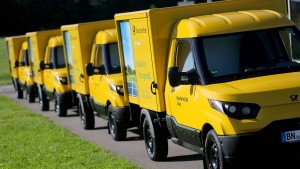A ls Frank Appel the motto was that Deutsche Post DHL should become a green corporation, he could not imagine this scenario yet: the CEO would once run a company that manufactures electric cars. Not at all, his imagination was so far that the largest postal and logistics service provider in the world would once show off the manufacturers of commercial vehicles.
![]()
That’s exactly what happened to the street scooter. Post does not only want to build the simply built electric van in large numbers for its own purposes, but also to offer it to third parties. For example, instead of the 20,000 electric transporters planned for the end of 2017, it would be possible to manufacture 100,000 units annually.
Only technically feasible for small trucks
The classic manufacturers of trucks and vans such as Daimler, VW, MAN , Renault, Volvo or Iveco are pretty tormented there. The established observe with eagle eyes, what the Bonn had announced not only two years ago, but actually implemented in all seriousness. The industry does not like to be cited openly. However, it is blatantly conceded in the industry that distribution is increasingly requiring electric vehicles. Such is the transport of goods by vans in cities and centers. These are for example the fleets of the parcel express services of DHL, UPS, GLS or DPD.
Daimler or MAN receives daily inquiries regarding the range of battery-operated vehicles with a payload of two to three tons. For larger trucks from 7.5 tons, however, electric drives are not realistic, economical and technically not feasible. Scania is in the experimental stage with a heavy hybrid truck that receives power from a catenary and is currently preparing a test on German motorways. But that is future music.
Electric cars of the Post: Slow, short range – but sufficient
Acknowledging is then admitted in the industry: The message of Deutsche Post has arrived. With the implementation, however, it hapert. German commercial vehicle manufacturers still need a lot of time to implement electromobility in the transporter sector for everyday use. Volkswagen has at the International Motor Show Commercial Vehicles ( IAA ) presented an “E-Crafter” in September of last year, which still takes years to mature. The transporter with 4.25 tonnes payload is expected to have a range of more than 200 kilometers at up to 80 kilometers per hour. The test drives will start this year.
There are also test runs with an e-van from Mercedes or pilot projects with an electrically powered Nissan eNV 200. Testers are express services. Hermes has even ordered 1500 electric Sprinter and Vitos from Mercedes. Quite brave: Because they will probably not be delivered before 2020 – then the street scooter car maker Deutsche Post have already made thousands of miles rounds.
Currently driving 2500 e-vans in the fleet, which are built as standard since 2015. The yellow cars, anything but priced in design, drive a maximum of 85 kilometers per hour quickly and only have a range of around 80 kilometers. In the city that’s enough for delivery. The entire postal fleet of 50,000 vehicles is to be gradually converted to battery operation.
